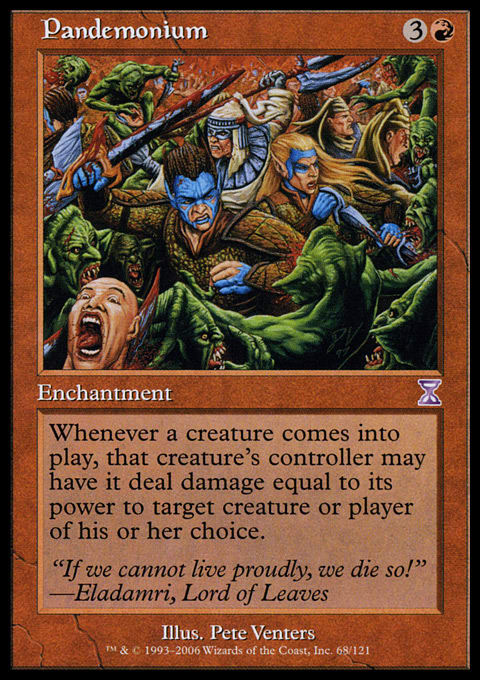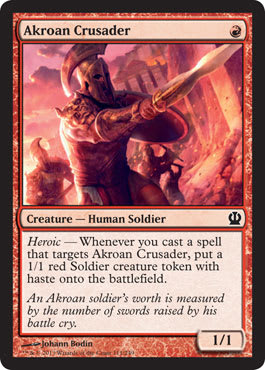In this experiment, we feel the tremors of Elves, Soldiers, Goblins, Saprolings, Squirrels, and Elephants, all in the Presence of Gond.
Pandemonium is a card that can do some very potent things, but it comes with huge risks. In a multiplayer game, for example, a player with a Pandemonium-focused deck may drop the 4-mana enchantment and be dead or close to it by the time his or her turn rolls back around. Once the Pandemonium player starts to drop some fatties, though—or whenever other players drop their fatties—things can be totally crazy and smash-facey . . . which is exactly what Pandemonium players like.
Warstorm Surge fixes the symmetrical nature of the effect. With the upgrade, though, comes a 2-mana increase in the upfront cost, which is pretty significant. If our deck is full of Warstorm Surges and fatties, what will we be doing on turns one through five? What slots do we have remaining in our deck? Perhaps we play ramp spells, but those are pretty disappointing when we just have those and the Surge.
Maybe we have a Pandemonium deck with Warstorm Surge as backup enchantments, and we can recoup lost life by playing fatties with lifelink, such as Brion Stoutarm and Spark Trooper.
Well, that was quite the tangent. The plan for today has very little to do with fatties or lifelink or spells that cost 6 mana. Rather, that was all a prolonged introduction for the tiniest of Pandemoniums: Impact Tremors.
Impact Tremors
When I first saw this Dragons of Tarkir common enchantment, my first comparison was to Pandemonium. There are some obvious differences.
- It costs 2 instead of 4. That’s a huge benefit!
- It’s not symmetrical—only we gain the effect. That’s also very beneficial!
- It can’t hit creatures. This is a downside.
- It hits each opponent. Pandemonium and Warstorm Surge have one target each, while Impact Tremors has as many “targets” as we have opponents.
- It only deals 1 damage. This is a drawback if we have 2-or-more-power creatures, but it’s neutral if all our creatures have 1 power.
When building a deck based on synergy with Pandemonium, we’d want to include a bunch of high-powered creatures. What we could also do, though, is use Pandemonium’s trigger as a reward for having creatures enter the battlefield. When considering infinite combos, it’s frequently possible to make creatures repeatedly enter and leave the battlefield, so finding triggers to turn that loop into a victory is important. I’ll often use the sacrifice outlet as the reward, but Wizards of the Coast is making fewer and fewer of those these days, instead requiring mana in addition to sacrifices for abilities’ costs.
But playing Pandemonium lets us turn infinite creatures entering the battlefield into a win, and Impact Tremors can do the same thing. Sure, it can’t hit creatures, and it only deals 1 damage each time, but neither of those is relevant when we’re looking for an effect for this situation (unless an opponent has Platinum Angel, but them’s the breaks).
Presence of Gond
I happened to know of an all-common combo that made infinite creatures, and I happened to be looking for an infinite-creature combo to play with Impact Tremors, so it seemed only natural to turn this list into a Pauper experiment.
I was amazed when Midnight Guard came out in Dark Ascension, as it provides a repeatable trigger, for no mana, that can be abused for a variety of effects depending on what types of Auras we put on it. The perfect Aura, as it turned out, had already existed.
Presence of Gond is an Aura that, for no mana, lets the enchanted creature tap to make a creature. As it turns out, the Midnight Guard will untap as soon as that Elf enters the battlefield, ready to tap to produce more Elves ad nauseam. And with Pandemonium, we can win the game right on the spot. For only 2 mana, Impact Tremors can do the same thing.
Of course, we could always just end the game on the subsequent turn by attacking with all our Elf tokens, but denying opponents of draw steps can be important, and it’s not as though we won’t have non-infinite ways to make use of Impact Tremors.
More Tokens
To fill out the rest of the deck, I went with a token-making theme in order to generate as many Impact Tremors triggers as I could with as few cards as possible.
Akroan Crusader — I envision this list as an aggressive deck with a possible combo finish, and for an aggressive deck, early drops can be important. This guy makes as many tokens as we can provide him fuel for, and that can be a lot of triggers. Attacking with him is fine, but when we don’t have a Midnight Guard around, enchanting the Crusader with Presence of Gond is fine—we’ll gain a bonus Soldier before the influx of Elves.
Kruin Striker — Prepping for all the token-making spells, here’s another aggressive creature. This one’s a 2-drop with 2 power, and its power only goes up as creatures enter the battlefield. Its trample will help make sure the damage goes through.
Mogg War Marshal — This has been a strong token-maker since its debut in Time Spiral. For only 3 mana, we’ll generate three Impact Tremors triggers, though its echo cost may sometimes bait us into delaying that third trigger. Still, the War Marshal is a small, early army all on his own.
Beetleback Chief — Printed as a common in Vintage Masters, this otherwise-uncommon Goblin generates three Tremors triggers for 4 mana, all upfront. And unlike its Mogg brethren, it’s a 2/2.
Fists of Ironwood — Here, the tokens really start. This is like a green Dragon Fodder that requires a creature to enchant. Can this really be better than just playing Dragon Fodder? Well, it does grant trample, but with all our 1/1s, that shouldn’t be huge most of the time. I just wanted another way to target Akroan Crusader, as doing so turns the two Saprolings into two Saprolings and a Soldier.
Elephant Guide — For the most part, I was looking for ways to make multiple small creatures from individual cards, and Elephant Guide doesn’t do that. But the Aura was pretty impressive in its day, and it still holds some sentimental value for me. When I saw it was a common in Vintage Masters, and thus eligible for Pauper play, I felt it would be a reasonable inclusion here. Its ability to keep up pressure after a previous threat has been dealt with is quite formidable, and of course, it’s another way to make a Soldier with Akroan Crusader.
Acorn Harvest — This spell provided the best return on investment I could find. For one card, we can make a potential of four Squirrel tokens. That’s 4 damage with Impact Tremors, in addition to the damage the Squirrels do through attacking. Sure, it costs a total of 6 mana and 3 life, but we can split it up along an installment plan.
Scatter the Seeds — Here’s an instant-speed, three-creature bonus, and it doesn’t even have to cost 5 mana if we have, say, some summoning-sick Squirrels sitting around.
Sprout Swarm — I didn’t include any copies of Sprout Swarm in the list, primarily because it’s a slower card. It makes half as many 1/1s as Fists of Ironwood for the same amount of mana. Its power comes in the form of buyback and, to a slightly lesser degree, convoke. In longer, grindier games, Sprout Swarm can completely take over, and that’s even truer with Impact Tremors on the battlefield. If you play a deck like this on Magic Online or in any kind of tournament format, certainly keep Sprout Swarm around for your sideboard.
Impact of Gond ? Casual | Andrew Wilson
- Creatures (18)
- 2 Beetleback Chief
- 4 Akroan Crusader
- 4 Kruin Striker
- 4 Midnight Guard
- 4 Mogg War Marshal
- Spells (20)
- 2 Scatter the Seeds
- 3 Acorn Harvest
- 3 Elephant Guide
- 4 Fists of Ironwood
- 4 Impact Tremors
- 4 Presence of Gond
- Lands (22)
- 1 Plains
- 7 Forest
- 9 Mountain
- 1 Blossoming Sands
- 1 Wind-Scarred Crag
- 3 Terramorphic Expanse
If you want just a little Pandemonium in your life, if you want to try some casual Pauper, or if you just want a bunch of different types of creature tokens on the battlefield at once, give this deck a try.
Andrew Wilson
fissionessence at hotmail dot com
































